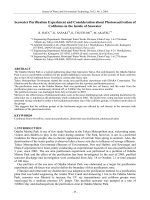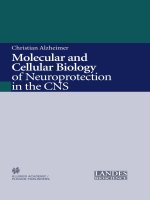molecular and cellular biology of neuroprotection in the cns - christian alzheimer
Bạn đang xem bản rút gọn của tài liệu. Xem và tải ngay bản đầy đủ của tài liệu tại đây (5.88 MB, 518 trang )
Christian Alzheimer
Molecular and
Cellular Biology
of Neuroprotection
in the CNS
Molecular and Cellular Biology
of Neuroprotection in the CNS
Molecular and Cellular Biology
of Neuroprotection in the CNS
Edited by
Christian Alzheimer
Institute of Physiology
University of Kiel
Kiel, Germany
Kluwer Academic / Plenum Publishers
New York, Boston, Dordrecht, London, Moscow
Molecular and Cellular Biology of Neuroprotection in the CNS
Edited by Christian Alzheimer
ISBN 0-306-47414-X
AEMB volume number: 513
©2002 Kluwer Academic / Plenum Publishers and Landes Bioscience
Kluwer Academic / Plenum Publishers
233 Spring Street, New York, NY 10013
Landes Bioscience
810 S. Church Street, Georgetown, TX 78626
;
Landes tracking number: 1-58706-104-X
10 987654321
A C.I.P. record for this book is available from the Library of Congress.
All rights reserved.
No part of this book may be reproduced, stored in a retrieval system, or transmitted in any
form or by any means, electronic, mechanical, photocopying, microfilming, recording, or
otherwise, without written permission from the Publisher.
Printed in the United States of America.
Library of Congress Cataloging-in-Publication Data
CIP applied for but not received at time of publication.
v
PREFACE
The adult mammalian brain is not well equipped for self-repair. Although
neuronal loss reinstalls parts of the molecular machinery that is essential for neuronal
development, other factors and processes actively impede regeneration of the
damaged brain. Many therapeutic efforts thus aim to promote or inhibit these
endogenous pathways. In addition, more radical approaches appear on the horizon,
such as replacement of lost neurons with grafted tissue.
Neurorepair, however, is not the topic of this book. Here, we go one step back
in the sequence of events that lead eventually to the demise of a neuronal population.
This book focuses on the precious period when an initial damaging event evolves
into a vast loss of neurons. The time frame might be hours to days in acute brain
injury or months to years in chronic neurodegenerative diseases.
Given the limited capacity of regeneration, protecting neurons that are on the
brink of death is a major challenge for basic and clinical neuroscience, with
implications for a broad spectrum of neurological and psychiatric diseases, ranging
from stroke and brain trauma to Parkinson´s and Alzheimer´s disease. In recent
years, rapid progress has been made in unravelling many of the cellular and molecular
players in neuronal death and survival. However, as the field develops into more
and more specialized branches, the notion of common pathogenic pathways of
neuronal loss might get buried under the wealth of novel data.
Thus it seems a timely endeavor to provide an overview on the most exciting
recent developments in neuroprotective signaling and experimental neuroprotection.
This book brings together experts from cellular and molecular neurobiology,
neurophysiology, neuroanatomy, neuropharmacology, neuroimmunology and
neurology. It is my hope that the book serves as a reference text for both basic
neuroscientists and clinicians, offering a fresh look at many (certainly not all) of the
highly intertwined processes that determine the fate of CNS neurons in the face of
acute or chronic insults.
The book is written mostly from the viewpoint of the basic scientist who works
at the cellular and molecular level, but who also develops and tests new hypotheses
using animal models of acute and chronic brain injury. Although many of the new
findings hold promise for therapeutic interventions, their translation into clinically
relevant neuroprotective strategies is still in its infancy. If this book helps to bridge
this gap, it will certainly be worth the effort.
vi
I thank my publisher, Ron Landes, for his support and the opportunity to put
this volume together. It was a pleasure working with Cynthia Dworaczyk, who
coordinated the production of this book in a most skillful fashion. Finally, I am
greatly indebted to the authors for their time and their valuable contributions.
Christian Alzheimer
Munich, February 2002
vii
PARTICIPANTS
Dr. Christian Alzheimer
Institute of Physiology
University of Munich
Pettenkoferstrasse 12
D-80336 Munich
Germany
Present Address:
Institute of Physiology
University of Kiel
Olshausenstrasse 40
D-24098 Kiel
Germany
Dr. Guiseppe Battaglia
Istituto Neurologico Mediterraneo
Neuromed
86077 Pozzilli
Italy
Dr. Christian Behl
Max Planck Institute of Psychiatry
Kraepelinstrasse 2-10
80804 Munich
Germany
Dr. Martin Berry
King´s College
GKT School of Biomedical Research,
Neuronal Damage and Repair
Centre for Neuroscience, Hodgkin
Building
Guy´s Campus—London Bridge
London SE1 1UL
UK
Dr. Ulrike Blömer
Department of Neurosurgery
University of Kiel
Weimarer Str. 8
D-24106 Kiel
Germany
Dr. Valeria Bruno
Istituto Neurologico Mediterraneo
Neuromed
86077 Pozzilli
Italy
Dr. Samantha L. Budd
Astra Zeneca
Södertälje Bioscience
14157 Huddinge
Sweden
Dr. Georg Dechant
Max-Planck-Institute of Neurobiology
Am Klopferspitz 18a
D-82152 Martinsried
Germany
Dr. Ulrich Dirnagl
Department of Neurology
Experimental Neurology
Charité
D-10098 Berlin
Germany
viii
Participants
Dr. Matthias Endres
Department of Neurology
Experimental Neurology
Charité
D-10098 Berlin
Germany
Dr. Peter J. Flor
Nervous System Research
Novartis Pharma AG
CH-4002 Basel
Switzerland
Dr. Gwenn Garden
Department of Neurology
UW School of Medicine
Seattle, WA 98195
U.S.A.
Dr. Arnold Ganser
Department of Hematology
and Oncology
Medical School Hannover
Carl-Neuberg-Strasse 1
D-30625 Hannover
Germany
Dr. Fabrizio Gasparini
Nervous System Research
Novartis Pharma AG
CH-4002 Basel
Switzerland
Dr. Saadi Ghatan
Department of Neurological Surgery
UW School of Medicine
Seattle, WA 98195
U.S.A.
Dr. Thomas Gillessen
Max-Planck-Institute of Psychiatry
Kraepelinstrasse 2 - 10
D-80804 Munich
Germany
Dr. Joseph T. Ho
Department of Neurological Surgery
UW School of Medicine
Seattle, WA 98195
U.S.A.
Dr. Yoshito Kinoshita
Department of Neurological Surgery
UW School of Medicine
Seattle, WA 98195
U.S.A.
Dr. Kerstin Krieglstein
Department of Anatomy
and Neuroanatomy
University of Göttingen
Kreuzbergring 36
D-37075 Göttingen
Germany
Dr. Sebastian Jander
Department of Neurology
University of Düsseldorf
Moorenstrasse 5
D-40225 Düsseldorf
Germany
Dr. Mark D. Johnson
Department of Neurological Surgery
UW School of Medicine
Seattle, WA 98195
U.S.A.
Dr. Stuart A. Lipton
The Burnham Institute
10901 North Torrey Pines Road
La Jolla, California 92037
U.S.A.
ix
Participants
Dr. Ann Logan
Molecular Neuroscience
Department of Medicine
Wolfson Research Laboratories
Queen Elizabeth Hospital
Edgbaston, Birmingham B15 2TH
United Kingdom
Dr. Hugo Marti
Institute of Physiology
University of Zürich
Winterthurerstrasse 190
CH-8057 Zürich
Switzerland
Dr. Richard S. Morrison
Department of Neurological Surgery
UW School of Medicine
Seattle, Washington 98195-6470
U.S.A.
Dr. Ferdinando Nicoletti
Istituto Neurologico Mediterraneo
Neuromed
86077 Pozzilli
and
Department of Human Physiology and
Pharmacology
University “La Sapienza”
Rome
Italy
Dr. Harald Neumann
Neuroimmunology
European Neuroscience Institute
Waldweg 33
D-37073 Göttingen
Germany
Dr. William M. Pardridge
Department of Medicine
UCLA School of Medicine
Los Angeles, California 90095-1682
U.S.A.
Dr. Rod J. Sayer
Department of Physiology
University of Otago
P.O. Box 913
Dunedin
New Zealand
Dr. Michaela Scherr
Department of Hematology and
Oncology
Medical School Hannover
Carl-Neuberg-Strasse 1
D-30625 Hannover
Germany
Dr. Michael Schroeter
Department of Neurology
University of Düsseldorf
Moorenstrasse 5
D-40225 Düsseldorf
Germany
Dr. Guido Stoll
Department of Neurology
University of Würzburg
Josef-Schneider-Strasse 11
D-97080 Würzburg
Germany
Dr. Trevor W. Stone
Division of Neuroscience
and Biomedical Systems
West Medical Building
University of Glasgow
Glasgow G12 8QQ
Scotland
x
Participants
Dr. Davide Trotti
Department of Neurology
Cecil B. Day Laboratory for
Neuromuscular Research
Massachusetts General Hospital,
Harvard Medical School
Charlestown, MA 02129
U.S.A.
Dr. Klaus Unsicker
Institute of Anatomy and Cell Biology
University of Heidelberg
Im Neuenheimer Feld 307
D-69120 Heidelberg
Germany
Dr. Sabine Werner
Institute of Cell Biology
ETH Hönggerberg
CH-8093 Zurich
Switzerland
Dr. Midori A. Yenari
Department of Neurosurgery
Stanford University
1201 Welch Road
MSLS Building P304
Stanford, California 94305-5487
U.S.A.
xi
CONTENTS
I. NEURONAL CELL DEATH—
OVERVIEW OF BASIC MECHANISMS
1
1. EXCITATORY AMINO ACID NEUROTOXICITY 3
Thomas Gillessen, Samantha L. Budd and Stuart A. Lipton
Historical Perspective 3
Clinical Relevance of Excitatory Amino Acid Neurotoxicity 5
Epilepsy 5
Traumatic Brain Injury 7
Hypoxia/Ischemia 7
Neurodegenerative Diseases 9
Intoxication with Exogenous Excitatory Amino Acids 9
Implication of Distinct Glutamate Receptor Classes in Excitotoxicity 10
Ionic Dependence of Excitotoxic Cell Damage 12
Mitochondrial Dysfunction 14
The Role of Reactive Oxygen Species
in Excitotoxicity 16
Role of Nitric oxide and other Reactive Nitrogen Species in Excitotoxicity 19
Excitotoxicity, Calcium Loading
and Apoptosis 21
Key Signaling Players in Neuronal Apoptosis 22
Conclusions 25
2. NEURONAL SURVIVAL AND CELL DEATH
SIGNALING PATHWAYS 41
Richard S. Morrison, Yoshito Kinoshita, Mark D. Johnson, Saadi Ghatan,
Joseph T. Ho and Gwenn Garden
Abstract 41
Introduction 41
Death receptor-Mediated Neuronal Apoptosis 42
Signal Transduction Pathways 48
Nuclear Signaling Pathways 53
p53-Mediated Cell Death Signaling Pathways 56
Bcl-2 Family Members and Mitochondrial Integrity 60
Proteolytic Enzymes 64
xii
Contents
Calpains 66
Abbreviations 66
3. DETRIMENTAL AND BENEFICIAL EFFECTS
OF INJURY-INDUCED INFLAMMATION
AND CYTOKINE EXPRESSION
IN THE NERVOUS SYSTEM 87
Guido Stoll, Sebastian Jander and Michael Schroeter
Abstract 87
Introduction 88
Glial Cell Populations in the Central Nervous System 88
Entry of Inflammatory Cells into the CNS: The Blood-Brain-Barrier
and Immunological Cell adhesion Molecules 89
Inflammation and CNS Injury 90
Beneficial Effects of Neuroinflammation 99
Acknowledgement 104
4. CELLULAR AND MOLECULAR DETERMINANTS
OF GLIAL SCAR FORMATION 115
Ann Logan and Martin Berry
Introduction 115
Development of the Scar 118
Axon Regeneration and Scarring 122
Cytokines and Scarring 124
Trophic Regulation of the Scar 133
Protease Regulation of Scarring 134
Therapeutic Modulation of the Scar 135
Conclusions 137
II. ION CHANNELS, RECEPTORS
AND SIGNALING PATHWAYS
159
5. Na
+
CHANNELS AND Ca
2+
CHANNELS OF THE CELL
MEMBRANE AS TARGETS
OF NEUROPROTECTIVE SUBSTANCES 161
Christian Alzheimer
Introduction 161
Na
+
Channels 162
Na
+
Channel Blockers as Neuroprotective Agents 168
Ca
2+
Channels 173
Acknowledgements 177
xiii
Contents
6. INTRACELLULAR Ca
2+
HANDLING 183
Rod J. Sayer
Abstract 183
Introduction 183
Cytosolic Ca
2+
Buffering 184
Ca
2+
Buffering and Neuroprotection 185
The Endoplasmic Reticulum Ca
2+
Store 187
The Endoplasmic Reticulum and Neuroprotection 188
Mitochondria and Ca
2+
Homeostasis 189
Mitochondria, Neurotoxicity and Neuroprotection 190
Future Challenges 191
7. NEUROPROTECTIVE ACTIVITY OF METABOTROPIC
GLUTAMATE RECEPTOR LIGANDS 197
Peter J. Flor, Giuseppe Battaglia, Ferdinando Nicoletti, Fabrizio Gasparini
and Valeria Bruno
Abstract 197
Introduction 198
Chemical Structures and Receptor Profile
of Neuroprotective mGluR Ligands 199
Physico-Chemical and Pharmacokinetic Properties of Neuroprotective
mGluR Ligands 202
Group-I mGluRs as Targets for Neuroprotective Drugs 204
Neuroprotection mediated by Group-II mGluRs 207
Role of Group-III mGluRs in Neuroprotection 211
Conclusions and Outlook 214
8. A ROLE FOR GLUTAMATE TRANSPORTERS
IN NEURODEGENERATIVE DISEASES 225
Davide Trotti
Introduction 225
The Na
+
/K
+
-Dependent High Affinity Glutamate Transporters 226
Localization of Glutamate Transporters 227
Functional Properties, Stoichiometry and Kinetics
of the Glutamate Transporters 227
Glutamate Transporter Topology 230
Role of Glutamate Transporters in the Excitatory Neurotransmission 230
Regulation of Glutamate Transporters 234
Glutamate Transporters in Disease States 236
Concluding Remarks 242
xiv
Participants
9. PURINES AND NEUROPROTECTION 249
Trevor W. Stone
Abstract 249
Adenosine 250
Adenosine Receptors 250
A2A Receptors 257
Abbreviations 270
10. HEAT SHOCK PROTEINS AND NEUROPROTECTION 281
Midori A. Yenari
Abstract 281
Introduction 281
Where and When is Hsp70 Expressed? 283
Correlative Evidence for a Neuroprotective Role 285
Neuroprotection with Hsp70 Overexpression 286
Potential Mechanisms of Protection 291
Conclusion 295
Acknowledgments 295
III. NEUROTROPHIC FACTORS
AS NEUROPROTECTIVE AGENTS
301
11. NEUROTROPHINS 303
Georg Dechant1 and Harald Neumann
Summary 303
From Neurotrophin Physiology to Therapy 303
Structure and Physiological Functions of Neurotrophins and Their Receptors 304
Neurotrophins in Animal Models of Pathological Situations
and Clinical Trials 314
Non-Neuroprotective and Side Effects of Neurotrophins 319
Potential Improvements of Neurotrophin Therapy 320
Acknowledgments 324
12. FIBROBLAST GROWTH FACTORS
AND NEUROPROTECTION 335
Christian Alzheimer and Sabine Werner
Introduction—Fibroblast Growth Factors (FGFs) and FGF Receptors 335
Distribution of FGFs in Adult Brain 336
FGFs and Neuronal Development 337
Upregulation of FGFs after Brain Injury 338
Neuroprotective Effects of FGF2 339
FGFs and Glia 340
Neuroprotective Mechanisms of FGF2 341
xv
Summary and Conclusions 343
Acknowledgements 345
13. TGF-
ββ
ββ
βS AND THEIR ROLES IN THE REGULATION
OF NEURON SURVIVAL 353
Klaus Unsicker and Kerstin Krieglstein
Abstract 353
Introduction 353
TGF-
ββ
ββ
βs: A Brief Overview of Their Molecular Biology, Biochemistry
and Signaling 354
Expression of TGF-
ββ
ββ
βs and T
ββ
ββ
βRs in the Nervous System 358
TGF-
ββ
ββ
βs and the Regulation of Proliferation, Survival
and Differentiation of Neurons 360
Regulation of Neuron Survival and Maintenance by Members
of the TGF-
ββ
ββ
β Superfamily Other Than TGF-
ββ
ββ
βs Proper 364
Conclusions 366
Acknowledgements 366
14. VASCULAR ENDOTHELIAL GROWTH FACTOR 375
Hugo H. Marti
The Members of the VEGF Family 375
Regulation of VEGF and VEGF Receptor Expression 378
Pleiotropic Action of VEGF in the CNS 380
Intracellular Signaling Events 387
Conclusion 387
Acknowledgments 388
IV. ADVANCES IN DRUG DELIVERY TO CNS NEURONS 395
15. BLOOD-BRAIN BARRIER DRUG TARGETING ENABLES
NEUROPROTECTION IN BRAIN ISCHEMIA FOLLOWING
DELAYED INTRAVENOUS ADMINISTRATION
OF NEUROTROPHINS 397
William M. Pardridge
Abstract 397
Blood-Brain Barrier, Neurotrophins and Neurological Disease 398
Chimeric Peptide Technology 401
Targeting Chimeric Neurotrophic Factors to the Brain 406
Targeting Gene Therapeutics to the Brain 423
Drug Targeting to the Human Brain 426
Acknowledgments 427
xvi
Participants
16. INVASIVE DRUG DELIVERY 431
Ulrike Blömer, Arnold Ganser and Michaela Scherr
Abstract 431
Vectors in Gene therapy 432
Direct DNA Delivery and Synthetic Nonviral Vectors 433
Viral Vectors and Gene Delivery 434
Herpes Simplex Viral Vectors 435
Adenoviral Vectors 436
Adeno-Associated Viral Vector (AAV) 437
Retrovirus 437
Biology of Retroviruses 438
Moloney Murine Leukemia Virus and Lenitvirus Based Vectors 440
Retroviral Gene Transfer Ex Vivo 441
Retroviral Gene Transfer In Vivo 443
Retroviral Vector Safety 444
Conclusion 445
V. NEUROPROTECTIVE STRATEGIES IN ANIMAL
AND IN VITRO MODELS OF NEURONAL DAMAGE
453
17. ISCHEMIA AND STROKE 455
Matthias Endres and Ulrich Dirnagl
Abstract 455
Epidemiological Data 455
Introduction 455
Gobal vs. Focal Ischemia 456
Animal Models of Cerebral ischemia 456
In vitro Models of Cerebral ischemia 458
Importance of Physiologic Parameters for Stroke Outcome 458
Pathophysiological Cascades Following Cerebral ischemia 459
Glutamate Receptors and Excitotoxicity 462
Tissue Acidosis 464
Protein Synthesis and Early Gene Expression 464
Molecular Mechanisms 466
Experimental Evidence for Caspase-Mediated Cell Death
Following Cerebral Ischemia 467
Caspase Inhibition Protects From Cerebral ischemia 467
Conclusion 468
18. NEUROPROTECTIVE STRATEGIES
IN ALZHEIMER'S DISEASE 475
Christian Behl
Introduction 475
What is the Cause of AD? 476
AD Genetics and Biochemistry 479
xvii
Neurotoxicology of A
ββ
ββ
β
482
AD Risk Factors 484
Mouse Models of AD 485
Clinical AD Therapy 486
Experimental AD Therapies 487
AD Prevention 489
Final Remarks 492
INDEX 497
I. NEURONAL CELL DEATH—
Overview of Basic Mechanisms
3
1
Institut fuer Pharmakologie und Toxikologie, Bereich Studien und Wissenschaft, Neuherbergstrasse 11,
80937 Muenchen, Germany; Present address: Max-Planck-Institute of Psychiatry, Kraepelinstrasse 2-10,
80804 Muenchen, Germany,
2
Astra Zeneca R&D Södertälje, Bioscience, 141 57 Huddinge, Sweden and
3
The Burnham Institute, 10901 Torrey Pines Road, La Jolla, CA 92037.
EXCITATORY AMINO ACID NEUROTOXICITY
Thomas Gillessen
1
, Samantha L. Budd
2
and Stuart A. Lipton
3
HISTORICAL PERSPECTIVE
The excitatory potency of the acidic amino acids glutamate and aspartate in various
regions of the central nervous system (CNS) has been recognized since the 1960’s.
1,2
Nevertheless, the earlier findings that these amino acids are (1) constituents of
intermediary metabolism and are (2) located in the brain ubiquitously in high
concentrations rendered them unlikely candidates as neurotransmitters. These
findings fueled a sustained debate about their physiological role as neurotransmitters
in the 1970s. Today, L-glutamate is accepted as the predominant fast excitatory
neurotransmitter in the vertebrate brain.
In parallel to studies on the physiological role of these amino acids, it has been
observed since the 1950s that glutamate can exert toxic effects on the nervous system
under certain conditions. Following the systemic application of glutamate to mice,
toxic effects on retinal neurons were described.
3
Further studies in the 1970s
corroborated these toxic effects and extended this view by showing neuronal cell
death following oral intake of glutamate or aspartate in brain regions devoid of the
blood-brain barrier in mice and nonhuman primates (Fig. 1).
4-9
Thus, L-glutamate is the primary excitatory transmitter in the mammalian CNS
but is cytotoxic under certain conditions. This relation between the physiological
function as excitatory amino acid (EAA) and the pathological effect is reflected by
the term “excitotoxicity” introduced in the 1970s by Olney et al.
10
With the introduction of structural transmitter analogues, local injections of the
glutamate agonist kainate were shown in the late 1970s and 1980s to induce cell
death with a similar pattern of damage in different brain regions, thus confirming
T. GILLESSEN ET AL.4
the neurotoxic effect.
11-14
Today, it is well recognized, that exogenous or endogenous
agonists of EAA receptors can induce cell death in CNS neurons.
Our knowledge about the role of glutamate as an excitatory neurotransmitter
and its cytotoxic effects increased in parallel during the 1980s, and notably, the
development of substances that antagonized the excitatory function
15
also stimulated
studies on mechanisms underlying the toxic effects.
16-18
The discovery of different
EAA receptor subtypes in conjunction with the introduction of selective receptor
antagonists revealed that the glutamate-induced cell death was induced by excessive
ionotropic glutamate receptor activation.
19-26
The view that activation of different ionotropic EAA receptors can induce
excitotoxic cell death was supported by subsequent studies on the ionic mechanisms
underlying excitotoxicity. It was demonstrated, that excessive calcium loading plays
a pivotal role in neuronal cell death following the intense stimulation of ionotropic
glutamate receptors,
27,28
and since then the implication of ion homeostasis
dysregulation and dysfunction in calcium signaling have been studied extensively
(Fig. 2).
29-33
Regarding the mode of cell death, glutamate-induced neuronal cell death has
been judged originally as necrotic from the morphological appearance.
6,34-36
However, the observation of a delayed neuronal cell death in the penumbra of
ischemic lesions
37
and after EAA exposure
38,39
has stimulated studies in the 1990s
focussing on the mode of cell death. Today, there is compelling evidence that failure
in extracellular glutamate homeostasis can result in different modes of cell death
Figure 1. A, Tissue section through arcuate nucleus (arc) of hypothalamus from a 10 day old mouse
(control; x150). No signs of pathology are present. B, Section trough arcuate nucleus (arc) from a 10 day
old mouse treated orally with 1 g/kg sodium glutamate (x150). There is a considerable number of necrotic
cells within the arcuate region. Reprinted with permission from Olney JW, Ho OL. Brain damage in infant
mice following oral intake of glutamate, aspartate or cysteine. Nature 1970; 227:609-611, copyright
1970 Macmillan Publishers Ltd.
5EXCITATORY AMINO ACID NEUROTOXICITY
with morphological and biochemical features of either apoptosis or necrosis de-
pending on the severity of the insult, with more fulminant insults causing rapid
energy failure because of lack of ionic homeostasis and thus necrosis.
40-44
CLINICAL RELEVANCE OF EXCITATORY AMINO ACID
NEUROTOXICITY
There is evidence that excitotoxicity is involved in acute brain damage under
pathophysiological conditions following status epilepticus, mechanical trauma or
ischemia (Fig. 3).
45
Moreover, glutamate cytotoxicity seems to be partly involved in
many neurodegenerative diseases.
EPILEPSY
Histopathological studies on the brains of patients suffering from chronic
epilepsy have revealed that certain brain regions show structural alterations with
severe loss of neurons and reactive gliosis.
46,47
Brain pathology in epilepsy is
described best for human temporal lobe epilepsy, resulting in sclerosis of the
hippocampus that extends into the amygdala and the parahippocampal gyrus and is
termed “mesial temporal sclerosis”, “hippocampal sclerosis” or “Ammon’s horn
sclerosis”. Pronounced brain damage has been observed following sustained
epileptiform activity with seizures lasting more than 30 min, called “status
Figure 2. Cortical neurons in cell culture before (top row) and 1 day after (bottom row) a 5 min incubation
in 500 µM glutamate. A, Na
+
ions replaced with equimolar choline. B, 1 µM tetrodotoxin added. C, Ca
2+
ions omitted. Considerable cell death occurred even under replacement of Na
+
or addition of 1 µM
tetrodotoxin. Omission of Ca
2+
resulted in a substantial decrease in neuronal cell loss. Reprinted with
permission from Choi D W. Glutamate neurotoxicity in cortical cell culture is calcium dependent. Neurosci
Lett 1985; 58:293-297, copyright 1985 Elsevier Science.
T. GILLESSEN ET AL.6
epilepticus” (SE).
48-50
Importantly, neuronal cell loss after SE is not distributed
equally across all hippocampal subfields and the extent of damage is in the order
CA1 > CA4 > CA3 > CA2, thus indicating different susceptibility to SE-induced
cell death.
12,50
In animal models of epilepsy using chemoconvulsant-induced or electrical
stimulation-induced SE, similar patterns of brain damage were observed.
51-54
Experiments aimed at the observation of ultrastructural changes have demonstrated
that certain features of cell damage, such as swelling of dendrites and soma, are
independent of the mechanism used to induce SE.
51-56
Evidence for the implication of EAA-mediated excitotoxicity in SE-induced
neuronal cell death arises from several experiments. First, the morphological
appearance of cell damage following SE is similar to damage following systemic or
local application of the glutamate receptor agonists L-glutamate, NMDA or
kainate.
6,36,51,53,55,56
Second, the administration of ionotropic glutamate receptor
antagonists that inhibit excitotoxic cell death in cultured neurons can prevent cell
death induced by epileptiform activity.
57-60
Apart from the above-mentioned evidence for excitotoxicity in epilepsy, there
has been a considerable debate regarding the mode of cell death. There is now a
large body of evidence suggesting the implication of both, necrotic and apoptotic
cell death following pathologically relevant EAA receptor activation. Recently,
several reports have added evidence for the implication of apoptotic pathways in
epilepsy-associated neuronal cell death.
61-66
In conclusion, the mode of cell death in
SE-induced brain pathology may be the result of intensity and duration of glutamate
Figure 3. Glutamate induces acute CNS injury. This historical schematic summarizes that seizures, hypoxia,
hypoglycemia and trauma share common mechanisms of acute injury. The excitatory activity of the
transmitter glutamate is linked to its toxic effects (excitotoxicity). Reprinted with permission from Choi
D W. Glutamate neurotoxicity and diseases of the nervous system. Neuron 1988; 1:623-634, copyright
1988 Elsevier Science.
7EXCITATORY AMINO ACID NEUROTOXICITY
receptor activation, with a shift from apoptotic death to necrotic death with increasing
intensity and duration of receptor activation.
40,43
TRAUMATIC BRAIN INJURY
Following head trauma, mechanical brain injury can be accompanied by
secondary changes as ‘metabolic’ glutamate leaks uncontrollably from the neuronal
cytoplasm
67
causing subsequent excitotoxic damage of surrounding neurons.
However, compared to research on mechanisms underlying the cell damage in
epilepsy, studies on traumatic injury have been sparse and there is less evidence for
the implicated modes of cell death. Some studies have suggested the sudden release
of excitatory amino acids from the cytoplasm into the extracellular space and
subsequent bioenergetic failure as well as ultrastructural damage that can be diminished
by NMDA antagonists, all indicative of excitotoxicity,
67-69
whereas others have
demonstrated activation of caspase enzymes, internucleosomal DNA fragmentation
and induction of immediate early genes, indicative of apoptosis.
69-71
Most recently,
in neonatal models of traumatic brain injury (TBI) (mortality and morbidity from
head trauma is highest in children), the resulting excitotoxicity has been shown to
elicit both apoptosis and necrosis. Necrosis occurs localized to the site of impact,
and within 4 hr of the insult, whereas a secondary apoptotic damage occurs between
6 – 24 hr and is found in the areas surrounding the primary necrosis.
72
In this model,
the secondary damage was more severe than the primary damage suggesting a
preponderance of apoptosis over necrosis.
HYPOXIA/ISCHEMIA
Under conditions of local or global ischemia, neurons are deprived of glucose
and oxygen, resulting in bioenergetic failure and subsequent decrease of ion gradients
across the plasma membrane.
73
The resulting plasma membrane depolarization leads
to increased synaptic release of glutamate, and the diminished Na
+
gradient is
followed by attenuated Na
+
-dependent glutamate uptake or even reversed glutamate
transport in terms of transporter-mediated release of glutamate from neurons and
astrocytes.
74-76
Moreover, osmotic cell swelling following the influx of Na
+
, Cl
-
and
H
2
O can result in plasma membrane rupture and further release of cytoplasmic
glutamate into the extracellular space. In summary, hypoxia/ischemia results in a
secondary net increase in the extracellular glutamate concentration.
77-79
As in the
other above-mentioned acute CNS insults, this increase in extracellular glutamate
results in excitotoxic damage.
80-83
The implication of excitotoxicity in hypoxia/
ischemia is corroborated by the observation that NMDA-type glutamate receptor
antagonists can reduce neuronal death in animal models of cerebral ischemia.
84-87
However, the actual set of circumstances in humans appears to differ from the defined
animal models.
88
In addition to the well-accepted concept of excitotoxicity-associated
acute necrotic cell death, there are several lines of evidence, that neurons can undergo
T. GILLESSEN ET AL.8
Table 1. Neurodegenerative diseases thought to be mediated at least in part
through stimulation of glutamate receptors
Huntington’s disease (pathologic process mimicked by injection of the endogenous NMDA agonist
quinolinate; mitochondrial inhibitors, which make neurons more susceptible to glutamate toxicity,
can reproduce this process)
AIDS dementia complex (human immunodeficiency virus-associated cognitive-motor complex) (evidence
that neuronal loss is ameliorated by NMDA antagonists in vitro and in animal models)
Neuropathic pain syndromes (e.g., causalgia or painful peripheral neuropathies with a central component
blocked by NMDA-receptor antagonists or inhibitors of nitric oxide synthase)
Olivopontocerebellar atrophy (some recessive forms associated with glutamate dehydrogenase deficiency)
Parkinsonism (mimicked by impaired mitochondrial metabolism, which renders neurons more susceptible
to glutamate-induced toxicity)
Amyotrophic lateral sclerosis (primary defect may be a mutation in superoxide dismutase gene, which may
render motor neurons more vulnerable to glutamate-induced toxicity; there is also evidence for
decreased glutamate reuptake)
Mitochondrial abnormalities and other inherited or acquired biochemical disorders (partial listing)
MELAS syndrome (mitochondrial myopathy, encephalopathy, lactic acidosis, and stroke-like episodes due
to a point mutation in mitochondrial DNA)
MERRF (myoclonus epilepsy with ragged-red fibers, signifying mitochondrial DNA mutation; also
frequently accompanied by ataxia, weakness, dementia, and hearing loss)
Leber’s disease (point mutation in mitochondrial DNA, presenting with delayed-onset optic neuropathy and
occasionally degeneration of basal ganglia, with dystonia, dysarthria, ataxia, tremors, and
decreased vibratory and position sense)
Wernicke’s encephalopathy (thiamine deficiency)
Rett syndrome (disease of young girls, presenting with seizures, dementia, autism, stereotypical hand
wringing, and gait disorder)
Hyperhomocysteinemia and homocysteinuria (L-homocysteine has been shown to be a weak NMDA-like
agonist as is L-homocysteic acid)
Hyperprolinemia (L-proline is a weak NMDA-like agonist)
Nonketotic hyperglycinemia (a case report of some improvement after treatment with an NMDA
antagonist)
Hydroxybutyric aminoaciduria
Sulfite oxidase deficiency
Combined systems disease (vitamin B12 deficiency, which may result in accumulation of homocysteine)
Lead encephalopathy
Alzheimer’s disease (data that the vulnerability of neurons to glutamate can be increased by ß-amyloid
protein)
Hepatic encephalopathy (perhaps a component, although inhibitory neurotransmitters are more clearly
involved)
Tourette’s syndrome (deficits in basal ganglia have been proposed to be mediated by glutamate or
glutamate-like toxins)
Drug addiction, tolerance, and dependency (animal modes suggest that NMDA antagonists may be helpful
in treatment)
Multiple sclerosis
Depression/anxiety
Glaucoma









